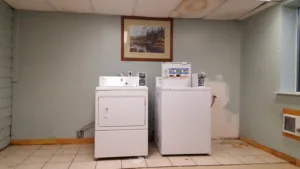I’ve been in the US week, working on our SID report, which we hope to get out early next week and attending the Augmented World Expo (AWE) in Santa Clara. My schedule meant that it was a bit of a flying visit – the show floor was only open for two days and on the first (when I could attend) it was only open from 11.00 am to 5:00 pm. I rushed around and saw a lot of interesting things. but I know I missed a few.
I was recently talking to someone who was commenting on my habit, when writing an editorial during my vacation (the news cycle never stops!), of posting a picture of the view from my desk. Well, on this Friday evening, I’m having an exciting time watching my laundry at my hotel! (I must admit, I have had a bit of luck as a favourite band happens to be playing not far from where I’m staying and when I checked, I found a single ticket in the fourth row – so I’m looking forward to that – the band rarely visits the UK!).
The glamourous view as I do my business trip laundry!
Anyway, we have slightly shorter issues this week, because of the event overload (we’re also trying to plan for Infocomm next week).
AWE is the key event for the AR world each year and was partly interesting because there was a split between the companies that are still in the development and start-up phase and that are still very keyed up about big growth and great new technology (where almost everyone was a couple of years ago) and those that are more seasoned, are shipping products for real world applications and are looking for ways to accelerate the growth of the industry. Unlike VR, where there is a lot of gamer and consumer interest, the AR world, at the moment, is dominated by commercial applications.
Although there are a lot of applications where AR really pays off, most companies are very cautious in working through one or more pilot programmes before moving to a roll out and high volume stage. In that way, it is like the early days of digital signage, when a German client memorably said to me that the digital signage industry had “more pilots than the Luftwaffe”. However, there are two key differences.
First, we had many requests in the early days of digital signage to get good data on the ROI in digital signage. However, that turned out to be difficult to quantify. Famously, early adopters of digital signage in retail found that while signage could move consumers from one brand or product to another, it was much harder to show an overall boost in spending. Other applications, such improvements in corporate communications, are hard to quantify in money terms. On the other hand, we are seeing lots of claims of 30% or 40% improvements in productivity which can go straight to the bottom line. However, those gains can only be made if the technology is used, so there is lots of work going on to make sure that good ergonomics, lifetime, certifications, battery life, safety and other issues are really well addressed. An HMD that nobody will wear is not much use.
The second difference is scale. There seem to be plenty of projects around at the level of thousands of units being needed, or even, in some cases, tens of thousands of units being needed. Again, with roll outs on that scale, customers will not want to have to work on warranty or other issues.
On the other hand, there are still lots of new companies that are just in the ‘building up the hype’ stage and that is also interesting in a different way.
Because of the SID report and Infocomm, the report may be a little delayed, but I’m sure you’ll find it worth the wait!
Bob

